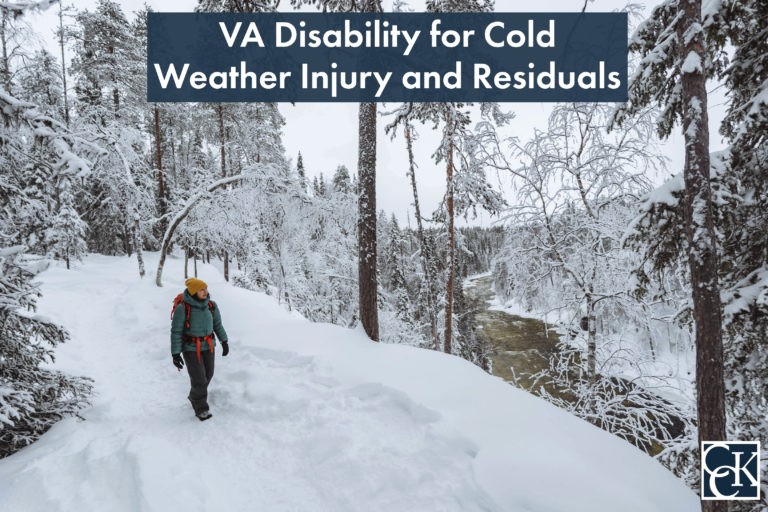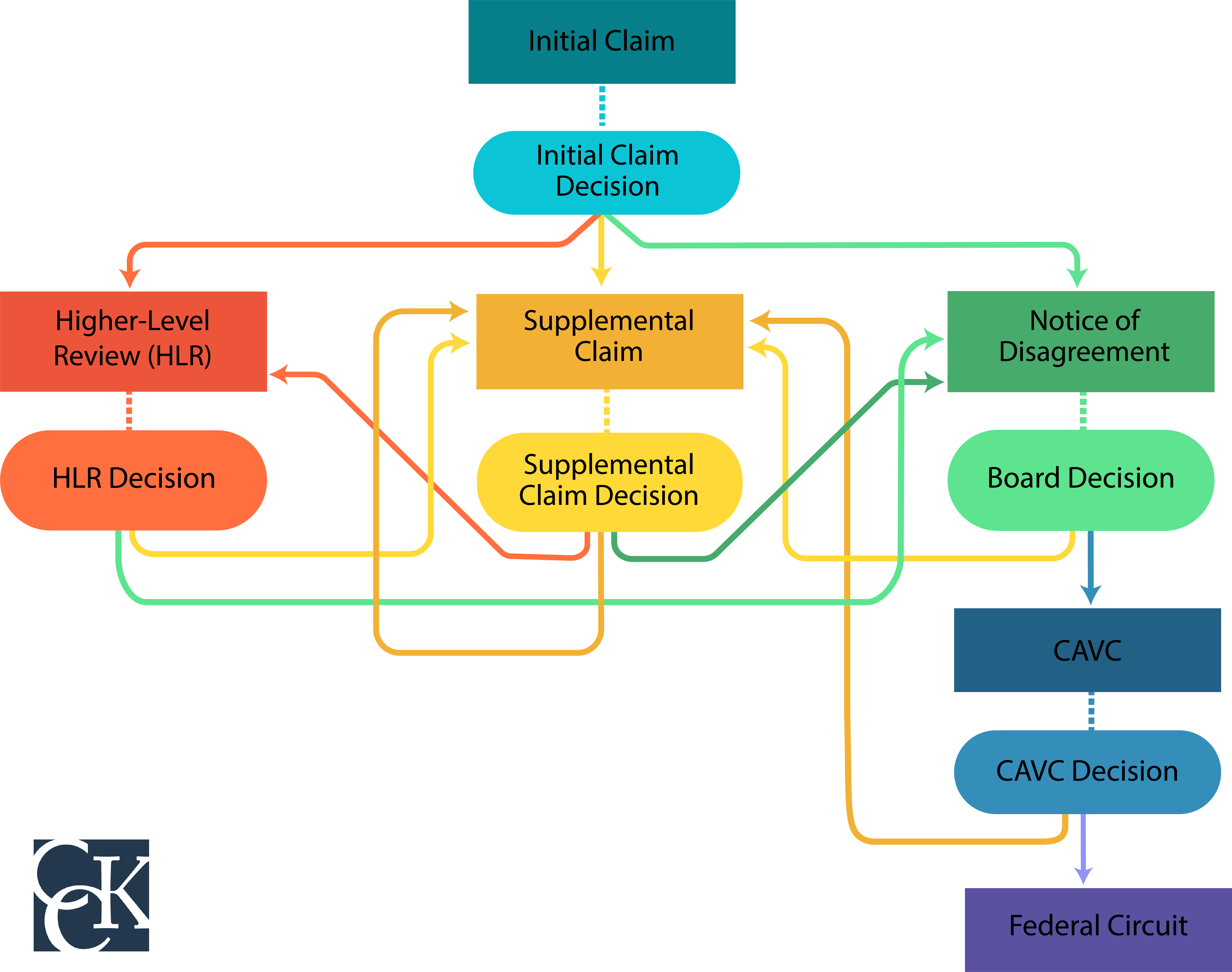VA Disability for Cold Weather Injury and Residuals

CCK Law: Our Vital Role in Veterans Law
What Is a Cold Weather Injury?
According to the Army Public Health Center, cold weather injury can occur when there is an imbalance of body temperature regulation, or where heat loss is greater than heat production in an area of the body. There are four primary types of cold injuries, including the following:
Hypothermia
Hypothermia is a dangerous drop in body temperature, usually caused by prolonged exposure to cold temperatures, severe wind, or wet clothing during periods of inactivity. Normal body temperature averages 98.6 degrees; however, with hypothermia, body temperature drops below 95 degrees.
Interestingly, hypothermia may also occur in warm climates during extended water exposure or immersion. Symptoms of hypothermia include shivering, dizziness, irritability, confusion, slurred speech, and stumbling.
When hypothermia progresses to a more severe phase, individuals usually experience the desire to sleep, a faint heartbeat and breathing, and even unconsciousness. Treatment for hypothermia depends on the extent and severity of the condition; however, common remedies include preventing further cold exposure, drinking warm liquids if conscious, rewarming with body-to-body contact, CPR if needed, and immediate medical evacuation.
Frostbite
Frostbite is an injury caused by freezing of the skin and underlying tissues. Frostbite mostly affects small, exposed body parts such as fingers and toes. It causes the skin to become very cold, then numb, hard, and pale. Specifically, the skin feels cold, stiff, or woody; turns to gray or waxy-white color; and numbness, tingling, or stinging sensations set in.
Frostbite may also cause blisters, absent/restricted joint movement, discoloration similar to superficial frostbite, hard underlying tissue, and purple or blackened skin. Similar to hypothermia, treatment involves removal from cold environments, preventing further heat loss, rewarming the affected area with body heat, etc.
Non-freezing Cold Injuries
Non-freezing cold injuries include those which involve the hands or feet and stem from exposure to wet conditions and temperatures that are just above freezing. Examples of non-freezing cold injuries include:
- Chilblains: A condition that occurs in cold, wet conditions due to prolonged exposure of bare skin; commonly affected areas include, ear, nose, fingers, and toes. Symptoms involve pale and colorless skin, achy sensation, and numbness, followed by red, swollen, hot, itchy, and tender skin upon rewarming.
- Immersion foot (i.e., trench foot): Results from prolonged exposure to water at temperatures below 50 degrees Fahrenheit; high risk during wet weather, wet areas, or when sweat accumulates in boots or glove. The skin initially appears wet, white, and shriveled with sensations of pins and needles, tingling, numbness, then pain. Discoloration (red, bluish, or black) will occur and the affected area will become cold, swollen, and waxy, possibly resulting in blisters, open weeping, or bleeding.
Other Injuries Related to Cold Exposure
Other injuries related to cold exposure include dehydration, sunburn, carbon monoxide poisoning, snow blindness, and slips, trips, and falls.
Relationship Between Cold Injury and Veterans
Active duty service members may have been exposed to extreme cold in combat and military training missions. However, the risk of cold injury depends on the environmental factors that service members are exposed to, such as temperature, wind, and moisture, in combination with physical activity, the duration of exposure, and the amount of protection. Importantly, the risk of cold injury may be different for each service member depending on their level of fitness and cold susceptibility.
According to VA, veterans may have been exposed to extreme cold without adequate protection during:
- World War II: The Battle of the Bulge – fought in December 1944 through January 1945 under conditions of extreme cold
- Korean War: The Chosin Reservoir Campaign, conducted from October 1950 through December 1950 in temperatures that dropped to 50 degrees below zero, with a wind chill factor of 100 degrees below zero.
- Vietnam War: many service members experienced cases of “trench foot”
- Operation Enduring Freedom (OEF) in Afghanistan
- Other campaigns or circumstances during military service, including training
Following the Korean War, the Army Medical Research Laboratory published findings related to cold injuries sustained by U.S. service members in Korea. During the conflict, the Army Hospital in Osaka, Japan was reserved for cold war casualties. While not all service members with cold injuries went to the Army Hospital in Osaka, a total of 4,216 patients were admitted with a diagnosis of a cold injury, representing more than one-half of the service members evacuated from Korea with the same conditions.
Using this large sample, studies were conducted to improve diagnosis, treatment, and management of cold injury conditions. Based on the data collected, four degrees of severity were developed in order to classify cold injuries, and more specifically, frostbite:
- First degree: characterized by numbness and patchy redness (i.e., erythema) on the affected part; most common sites for first-degree frostbite were toes, heels, plantar surfaces of the feet, and fingertips
- Second degree: blistering of the skin; most common sites for second-degree frostbite were the toes and heels
- Third degree: thickening of the skin, extending into subcutaneous tissue. Third-degree frostbite also occurred mainly on the toes, heels, and fingertips and patients typically described burning, aching, throbbing, and shooting pains within the first 1-2 weeks of onset of the cold injury; such pain could last anywhere between 2-8 weeks.
- Fourth degree: damage to the entire thickness of the skin, including part of the bone that, most often results in loss of the affected area
Health Problems Associated with Cold Injury
Although most cold injuries can be resolved with minimum damage, the loss of one or two fingers, or other larger body parts, is not uncommon. Nonetheless, cold injuries may result in other long-term health problems as well, including the following:
- Changes in muscle, skin, nails, ligaments, and bones
- Skin cancer in frostbite scars
- Neurological injury with symptoms such as bouts of pain in the extremities, hot or cold tingling sensations, and numbness (e.g., peripheral neuropathy)
- Vascular injury with Raynaud’s Phenomenon with symptoms such as extremities becoming painful and white or discolored when cold
Service Connection for Cold Injury
Veterans may file a claim for disability compensation for health problems they believe are related to cold injuries during military service. Importantly, VA decides these claims on a case-by-case basis. When applying for disability benefits for cold injuries, veterans should be sure to have substantial medical evidence to support their claim.
Any veteran examined for residuals of cold injury should undergo a cold injury protocol examination if it has not already been carried out following discharge from service. This examination can then be used as medical evidence.
When carrying out a cold injury protocol examination, VA should review the veteran’s medical history and subjective complaints. Information gathered during the examination should include: description of the circumstances of the cold injury, parts of the body affected, signs and symptoms (at time of acute injury), type of treatment and where it was administered (if any), any treatment since service (if any), and current symptoms. The examination itself should assess the affected area for the following:
- Color
- Edema
- Temperature
- Atrophy
- Dry or moist
- Texture
- Ulceration
- Hair growth
- Evidence of fungus or other infection
- Scars, including location, length, width, color, tenderness, raised/depressed, disfigurement (if located on head or neck)
- Nails (i.e., all or part missing, evidence of fungus infection, deformed or atrophic)
- Neurological (e.g., reflexes, motor skills)
- Orthopedic issues (e.g., pain or stiffness of any joints affected by cold injury)
- Vascular issues (e.g., evidence of Raynaud’s phenomenon)
Ultimately, the examiner should list each diagnosis and state whether related to cold injury and determine if any specialty exams (e.g., neurology, dermatology) are needed.
How VA Rates Cold Injury
VA rates cold injuries under 38 CFR § 4.104 – Schedule of Ratings, Cardiovascular System, Diagnostic Code 7122. The rating criteria is as follows based on the affected parts:
- 30% – arthralgia or other pain, numbness, or cold sensitivity plus two or more of the following: tissue loss, nail abnormalities, color changes, locally impaired sensation, hyperhidrosis, X-ray abnormalities (osteoporosis, subarticular punched out lesions, or osteoarthritis)
- 20% – arthralgia or other pain, numbness, or cold sensitivity plus tissue loss, nail abnormalities, color changes, locally impaired sensation, hyperhidrosis, or X-ray abnormalities (osteoporosis, subarticular punched out lesions, or osteoarthritis)
- 10% – arthralgia or other pain, numbness, or cold sensitivity
Importantly, VA should separately evaluate any amputations of fingers or toes, and complications such as squamous cell carcinoma at the site of a cold injury scar or peripheral neuropathy, under other Diagnostic Codes. Other disabilities that are diagnosed as the residual effects of cold injury (e.g., Raynaud’s phenomenon, muscle atrophy) should also be rated separately unless they are used to support an evaluation under Diagnostic Code 7122. Each affected body part (e.g., hand, foot, ear, nose) should be rated separately and then combined.
About the Author
Share this Post

